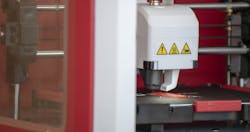Two new posters about 3-D printing safety have been published by the National Institute for Occupational Safety and Health (NIOSH), promoting healthy and safe operations.
The warnings could turn out to be quite timely. News reports have spotlighted feel-good stories about individuals at home and a number of businesses that have been cranking out protective facemasks to protect medical and other essential workers during the Coronavirus pandemic. It turns out that, depending on the kinds of the materials they are using, they may need to wear facemasks themselves while making them.
Concern over 3-D printer emissions has risen in recent years as the devices have become more prevalent for making all sorts of industrial parts and popular among home hobbyists. As 3-D printers grow bigger and more capable of making different things, it is predicted that their use will grow to the point where a substantial percentage of products like automobile and airplane parts will be manufactured this way, increasing supply chain efficiencies by decreasing the need for transportation and warehousing.
Research has continued at the national and international level about printer emissions safety. The Occupational Safety and Health Administration (OSHA) has reiterated concerns it originally had raised for employers in 2014 after a 3-D printing company was cited for an explosion and fire occurred because of combustible dust emissions.
The Environmental Protection Agency (EPA) teamed up with the Consumer Products Safety Commission (CPSC) to study the impact of harmful emissions produced during the 3-D printing process. Also conducting research on 3-D printer nanomaterials is the National Institute of Standards and Technology (NIST).
The two posters address different control options and offer information about how to reduce exposure to potential hazards The first poster issued by the NIOSH Nanotechnology Research Center (NTRC) warns that when printing with filaments, consideration should be given to the printing material used, such as using polylactic acid (PLA) filament rather than acrylonitrile butadiene styrene (ABS) when possible.
Other areas of concern are filaments with additives (such as metals, nanomaterials and carbon fibers), and the frequency and duration of the printing process. Additional potential hazards may include breathing and skin contact with volatile organic chemicals (VOCs) and particulates (printing) and other chemicals (post-printing), as well as hot surfaces and moving parts.
NTRC stresses that work environment best practices should include printing in a negatively pressured area with a dedicated ventilation system, in an area away from other work; and by reducing the amount of time spent near the printing process (for example, monitoring the process remotely, such as with a video camera, or choosing to leave the area during printing).
There is a higher potential for exposures when using a printer in a general office work area, working near the printer, and going to the printer too quickly after print failures occur and during start up. Potential for exposures also is higher when removing support structures with solvents or other chemicals, along with other post-processing activities with filaments containing nanomaterials.
NTRC recommends selecting the lowest printing temperature that is capable of achieving the desired product and, whenever possible, choosing to use a filament with lower known emission rates.
The second poster deals with printing safely while using metal powders. Potential dangers arise from breathing and skin contact with metals, as well as static causing fire and explosion. A higher potential for exposures occurs when loading powders manually into the machine and sieving powder outside of the machine.
The center advises the use of a ventilated glove box or containment system (for example, during cleaning and finishing activities) and ventilated sieving or powder dumping stations, along with local exhaust ventilation when handling powders outside of containment area and sticky mats on floors at printing or powder handling area exits/entrances. Other recommended practices include the use of HEPA-filtered and fire/explosion-appropriate waste vacuum and the grounding and bonding of equipment for static, fire and electrical safety.
In fact, with metal powders the chief dangers come from lack of containment and exposure to others in the same work area. NTRC notes that printing with metal powders is typically performed in an enclosed chamber, and the potential for exposure to emissions during operation is low. Containment or local exhaust ventilation close to powder handling activities should be HEPA-filtered and fire/explosion appropriate.
Both posters also recommend similar additional safe practices that apply to the use of both kinds of materials, such as incorporating filament and metal safety practices into workplace safety programs and developing training protocols, and use signs to alert workers of hazards and appropriate actions to protect themselves.
About the Author

David Sparkman
David Sparkman is founding editor of ACWI Advance, the newsletter of the American Chain of Warehouses Inc. He also heads David Sparkman Consulting, a Washington, D.C. area public relations and communications firm. Prior to these he was director of industry relations for the International Warehouse Logistics Association. Sparkman has also been a freelance writer, specializing in logistics and freight transportation. He has served as vice president of communications for the American Moving and Storage Association, director of communications for the National Private Truck Council, and for two decades with American Trucking Associations on its weekly newspaper, Transport Topics.
